Sabudana Vada is a traditional Indian snack made with sago (tapioca pearls) and potatoes. It is also known as the sabudana cutlet. Learn how to make sabudana vada on a stovetop and air fryer.
What is Sabudana?
Sabudana is the Hindi term for tapioca pearls. It is also known as sago. Sabudana is a plant-based ingredient made with starch from tapioca roots. Later, the starch is processed to form tiny grain-like spherical pearls.
Sago is widely used in Southeast Asian countries to make desserts, pudding, bubble tea, or snacks.
In India Cuisine, sago pearls are commonly used to make various dishes. Many people consume it while observing religious fastings such as Navratri, Ganesh Chaturthi, or any other Hindu festival.
About Sabudana Vada
In India, the sabudana cutlet is a widely popular vegetarian snack. It is an excellent, vegan, and gluten-free snack. You can serve it as a teatime snack or for breakfast with spicy green chutney and a cup of masala tea.
There are many versions of the sabudana vada recipe. In a Marathi Style, sabudana cutlet lot of crushed peanuts, roasted cumin powder, and grated ginger are added.
Whereas, in a typical North Indian style sabudana cutlet, we add loads of chopped onion, spices, and fresh coriander.
I am sharing an easy Marathi Style sabudana vada recipe that you can deep-fry or cook in an air fryer.
Watch Sabudana Vada Video
Air Fryer Sabudana Vada (Farali Snack)
To make a sabudana vada for vrat (fasting), all you need is – sabudana (tapioca pearls), boiled potatoes, green chili, fresh coriander, rock salt/sendha namak (optional), cumin powder, black pepper, crushed peanuts, and ghee.
Ensure these ingredients are not used – onion, garlic, ginger, turmeric, table salt, spices, and refined oil, in a farali sabudana vada.
To air fry, the vada, brush the air fryer basket with a teaspoon of ghee.
- Preheat the air fryer to 180-degree celsius. Once the air fryer is ready, arrange sabudana vada on the basket. Do not overcrowd the basket.
- Air Fry the vada for 20 minutes. Flip them after 10 minutes for even browning and cooking.
Once ready, serve farali sabudana vada with chutney.
My Tried & True Tips
Many times people complain about soggy, broken, or under-cooked sabudana vada. Follow these tried and tested tips to say goodbye to all the woes related to the sabudana cutlet.
Soaking Sabudana: It is best to soak sago overnight or for at least 5 – 6 hours. The ratio of 1:1 (sago to water) always works for me. Too much water while soaking sago makes it mushy and water clogged, resulting in a not-so-crisp cutlet.
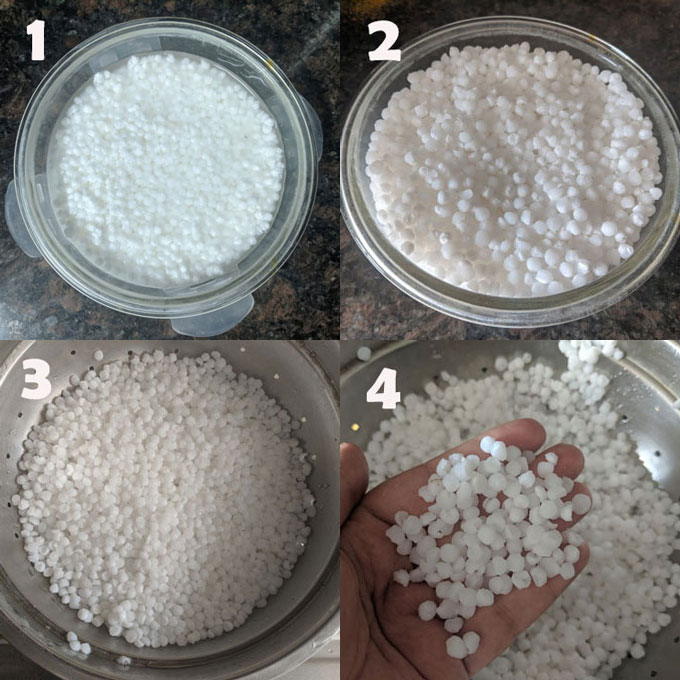
Boiled Potato: I prefer to boil the potatoes well in advance, allow to cool, remove the skin, and keep them in the fridge. The chilled, firm potatoes do some kind of magic to the texture of the cutlet, turning them into crisp goodness.
Peanuts: Use roasted peanuts without skin to add to the vada mixture. Crush the peanut using a rolling pin or mixer to make a coarse powder.
Cutlet Shape: If you are not too keen to shape the cutlet into the perfect round, simply pinch a small portion of the dough mixture using your fingers and gently drop it in hot ghee for frying. The bite-size sabudana pakodi tastes exquisite.
To test if the oil is ready for frying, drop a pinch of the vada mixture into the hot oil. If the oil is hot enough, the vada mixture will immediately float on the surface rather than sticking to the bottom of the pan.
Once you add vada to hot oil, reduce the heat to medium. If the vada is fried at very high heat, they get burnt from the outside instead of turning crisp and remain uncooked from the inside.
Do not overcrowd the pan while frying sabudana vada. Fry them in small batches. I would not suggest flipping vada multiple times while frying. Once it turns crisp from one side, flip it once, and cook from the other side.
FAQs Related To Sabudana Vada
Whenever there is excess moisture in the vada mixture, it has more chances to break while frying. Even if the oil is not heated at the right temperature, vada will absorb more oil and fall apart while frying.
It’s important to soak sabudana with just enough water to cover it. You can soak it for 5 – 6 hours or overnight. After 6 hours, you will find perfectly puffed-up sabudana pearls ready to make vada or sabudana khichdi. Also, ensure to drain all the excess water, if any, from the soaked sago.
Yes, absolutely. You can keep soaked sabudana in the fridge for up to 2 – 3 days in an airtight container.
Yes, you can. Preheat the air fryer to 180 degrees Celsius. Arrange the vada on the tray of the air fryer in a single layer. Spray with oil. Air fry for 20 minutes or until golden brown from both sides. I have fried them on Instant Pot Crispy Lid as well. They take 10 minutes on each side at the same temperature.
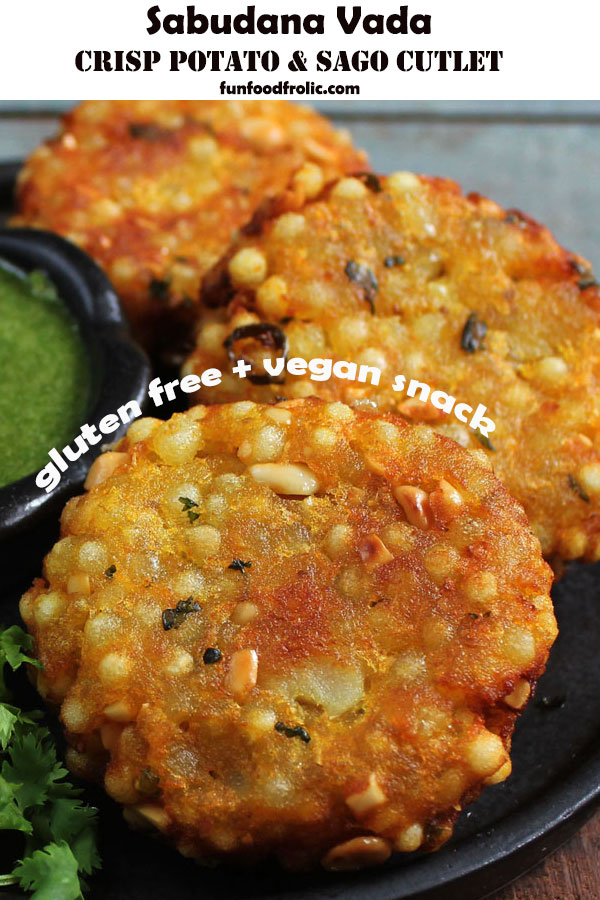
More Cutlet Recipes
Subscribe to our weekly newsletter or follow us on Instagram for video recipes.
If you try this recipe and love it, please leave a comment and a rating. This helps us grow and reach other food lovers like you.
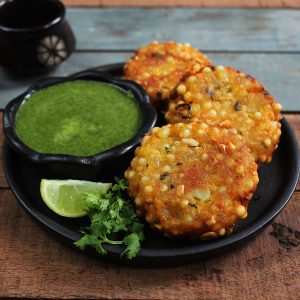
Sabudana Vada Recipe
Ingredients
- 1 Cup sago (sabudana or tapioca pearls)
- 4 medium-size potato, boiled and mashed
- ¼ Cup roasted peanuts, crushed
- 1 tablespoon grated ginger
- 2 tablespoon chopped coriander
- 1 green chili, finely chopped
- Salt to taste
- 1 teaspoon turmeric powder (optional)
- 1 teaspoon red chili powder
- 1 teaspoon cumin powder
- 2 Cup vegetable oil, for deep frying
Instructions
- To prepare the Sabudana Vada, soak the tapioca pearls (sabudana), in 1 cup of water for about 4 – 5 hours or overnight.
- Next day, transfer the soaked sago into a metal colander to drain all excess water.
- To prepare the mixture for the vada, in a large mixing bowl combine boiled potato, soaked sabudana, ginger, chili, peanuts, coriander, salt, and spices.
- Mix thoroughly while mashing the mixture with your finger to form a smooth non-sticky dough-like mixture for the vada.
- Heat oil for deep frying in a pan over medium flame.
- While the oil is heating, divide the mixture into small sized balls. Next, flatten the balls to half inch or so thickness gently using fingers.
- Shallow fry or deep-fry the vada in small batches in hot oil till golden brown and crisp from both the sides.
- Drain Sabudana Vada on an oil absorbent paper.
- Serve Sabudana Vada with green chutney and a cup of tea.
Recipe Notes:
- It is best to soak sago overnight or for at least 5 – 6 hours. The ratio of 1:1 (sago to water) always works for me.
- I usually boil the potatoes beforehand and keep them in the fridge. This way, I always get perfectly crisp sabudana vada.
- Do not overcrowd the pan while frying sabudana vada. Fry them in small batches.
- Do not fry the vada at very high heat. It will burn from the outside and remain uncooked from the inside. Resulting in a chewy, bitter-tasting vada.
-
To air fry, the vada, brush the air fryer basket with a teaspoon of ghee.
- Preheat the air fryer to 180-degree celsius. Once the air fryer is ready, arrange sabudana vada on the basket. Do not overcrowd the basket.
- Air Fry the vada for 20 minutes. Flip them after 10 minutes for even browning and cooking.

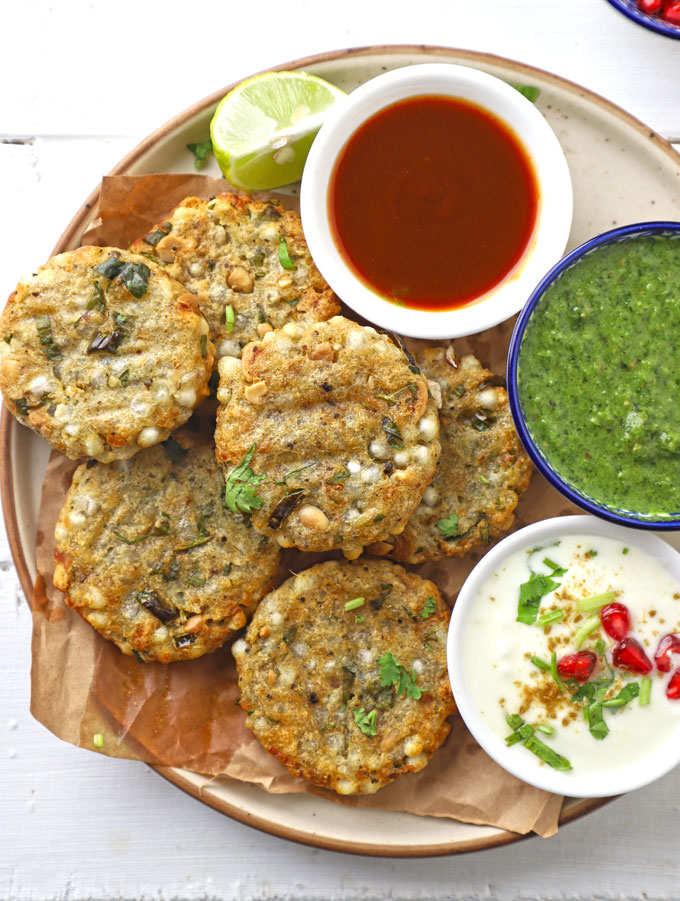

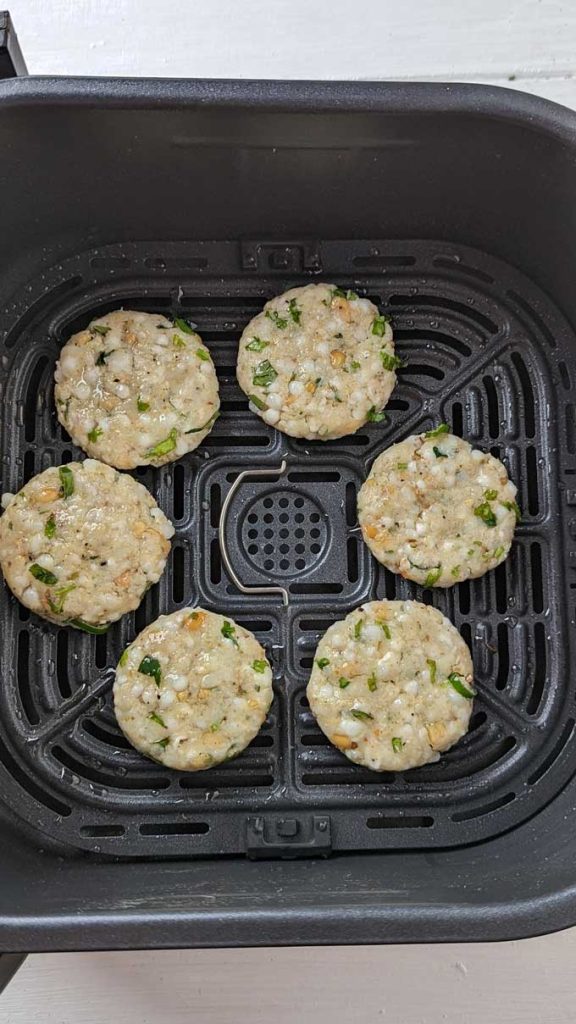
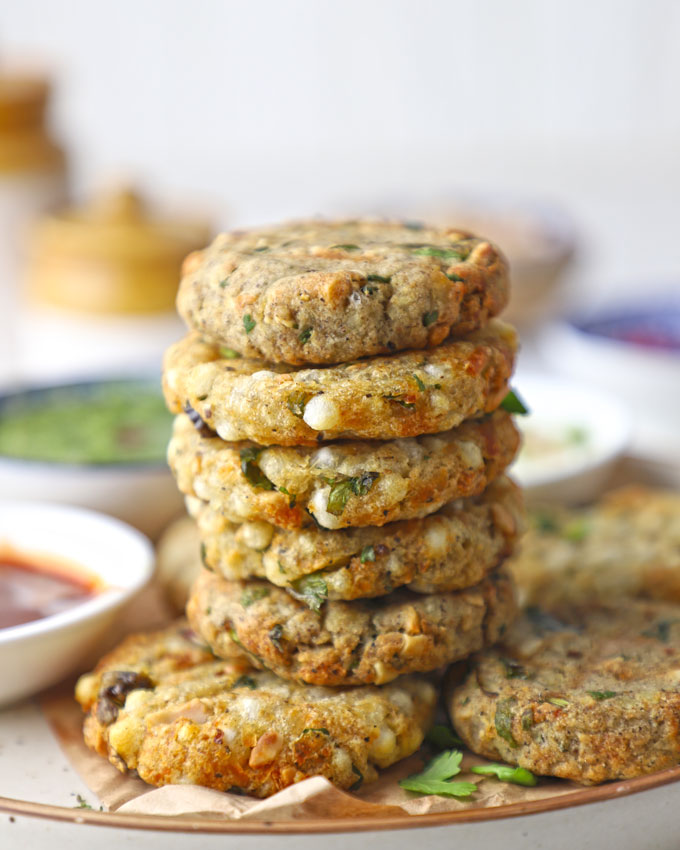
Sumit says
Nice one.. will surely try it:)
Sandra says
Very inviting n perfect looking vada!!
http://www.unnatisilks.com/
Banarasi saree online says
awesome vada…shivratri is near will definitely try this recipe
Hina Gujral says
Great. Hope you like it!
Cynthia Thivy says
Delicious
Hina Gujral says
Glad you like it!